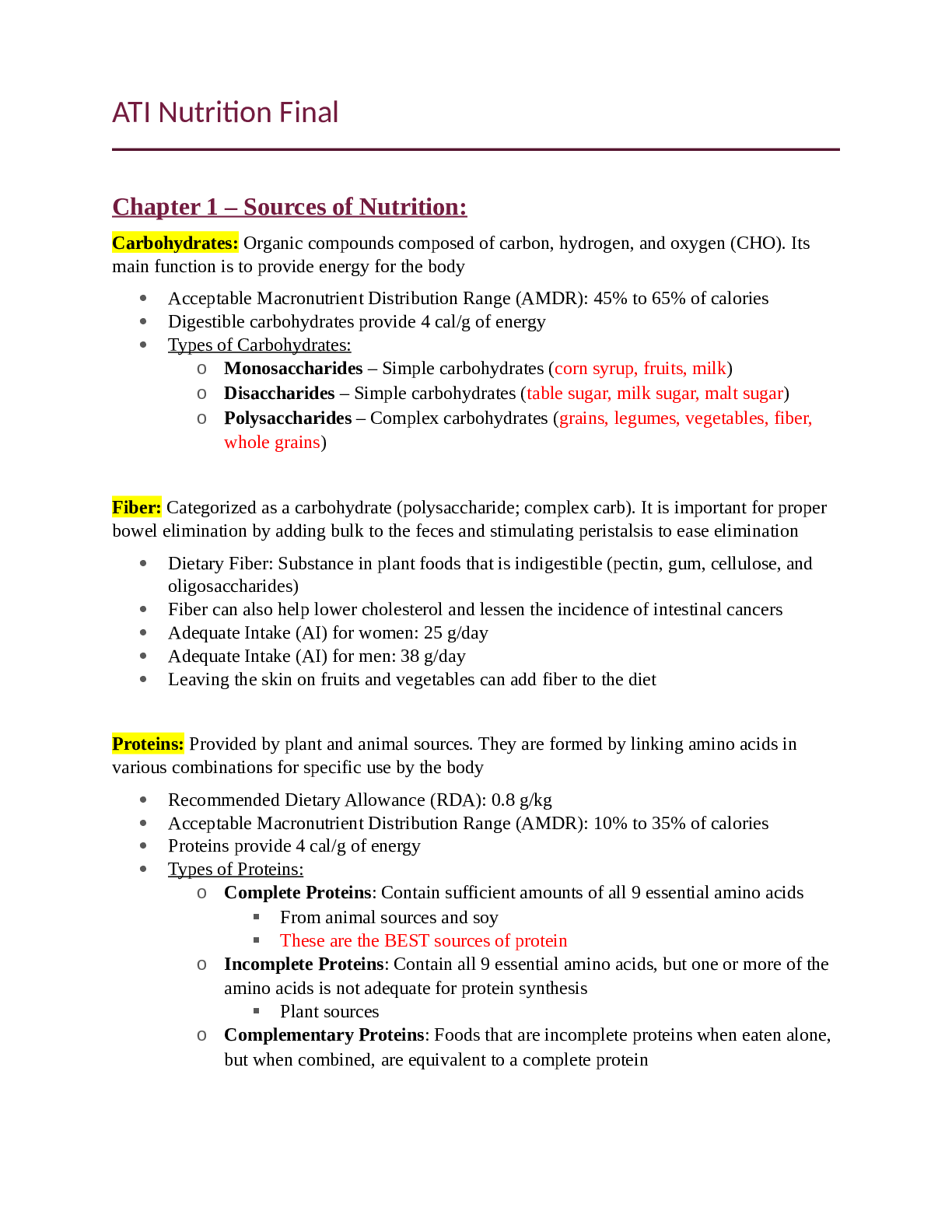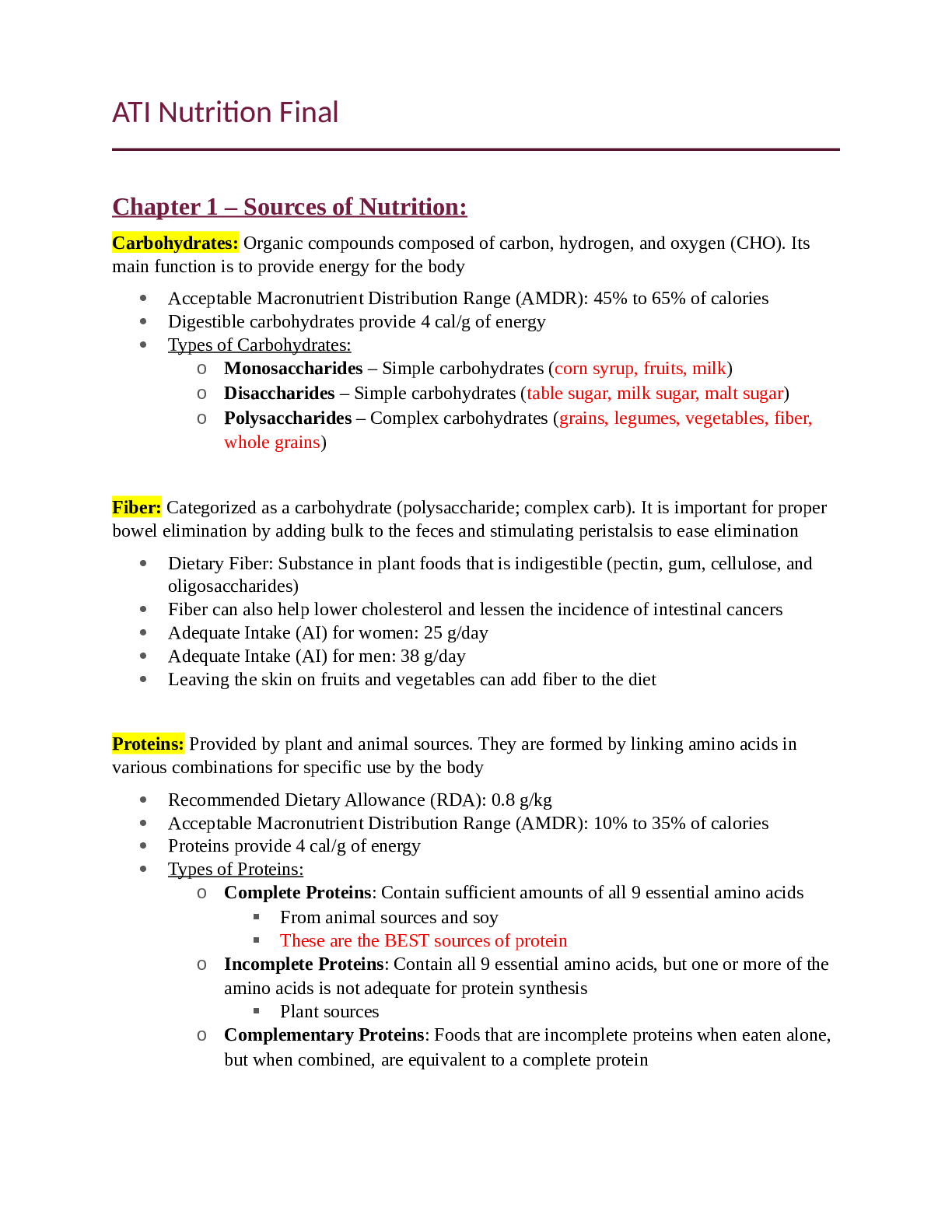ATI Nutrition Final
Chapter 1 – Sources of Nutrition:
Carbohydrates: Organic compounds composed of carbon, hydrogen, and oxygen (CHO). Its
main function is to provide energy for the body
Acceptable Macronutrient Distribution Range (AMDR): 45% to 65% of calories
Digestible carbohydrates provide 4 cal/g of energy
Types of Carbohydrates:
o Monosaccharides – Simple carbohydrates (corn syrup, fruits, milk)
o Disaccharides – Simple carbohydrates (table sugar, milk sugar, malt sugar)
o Polysaccharides – Complex carbohydrates (grains, legumes, vegetables, fiber,
whole grains)
Fiber: Categorized as a carbohydrate (polysaccharide; complex carb). It is important for proper
bowel elimination by adding bulk to the feces and stimulating peristalsis to ease elimination
Dietary Fiber: Substance in plant foods that is indigestible (pectin, gum, cellulose, and
oligosaccharides)
Fiber can also help lower cholesterol and lessen the incidence of intestinal cancers
Adequate Intake (AI) for women: 25 g/day
Adequate Intake (AI) for men: 38 g/day
Leaving the skin on fruits and vegetables can add fiber to the diet
Proteins: Provided by plant and animal sources. They are formed by linking amino acids in
various combinations for specific use by the body
Recommended Dietary Allowance (RDA): 0.8 g/kg
Acceptable Macronutrient Distribution Range (AMDR): 10% to 35% of calories
Proteins provide 4 cal/g of energy
Types of Proteins:
o Complete Proteins: Contain sufficient amounts of all 9 essential amino acids
From animal sources and soy
These are the BEST sources of protein
o Incomplete Proteins: Contain all 9 essential amino acids, but one or more of the
amino acids is not adequate for protein synthesis
Plant sources
o Complementary Proteins: Foods that are incomplete proteins when eaten alone,
but when combined, are equivalent to a complete protein
Sources of Protein:
o Meats (beef, pork, poultry), Seafood
o Eggs (complete protein)
o Kidney beans
o Soy. soybeans (complete protein)
o Seafood
o Nuts and seeds (incomplete protein)
o Cottage cheese (complete protein)
o Peanut butter (incomplete protein)
o Whole grain cereal (incomplete protein)
Lipids (Fats): Divided into 3 groups – triglycerides, phospholipids, and sterols. Lipids are
available from many sources such as dark meat, poultry skin, dairy foods, and added oils
(margarine, butter, shortening, oils, lard). Lipids are the densest form of stored energy
Acceptable Macronutrient Distribution Range (AMDR): 20% to 35%
Lipids provide 9 cal/g of energy
Triglycerides:
o Saturated Fatty Acids (“bad fat,” primarily found in animal sources)
No more than 10% of total calories should come from saturated fats
o Unsaturated Fatty Acids (“good fats,” usually from plant sources; help reduce
health risks)
Monounsaturated: Olives, canola oil, avocado, peanuts, and other nuts
Polyunsaturated: Corn, wheat germ, soybean, safflower, sunflower, and
fish
o Essential Fatty Acids (must be supplied by the diet; support blood clotting, blood
pressure, inflammatory responses, and many other metabolic processes)
Omega-3 and Omega-6 fatty acids
Phospholipids (e.g., lecithin):
o Important to cell membrane structure
Sterols (e.g., cholesterol):
o Found in the tissues of animals
o Not an essential nutrient – Should be limited to 200-300 mg/day
o If consumed in excess, it can build up in tissues, causing congestion and increased
risk for cardiovascular disease:
Vitamins: There are 13 essential vitamins that each have a specialized function. Vitamins are
divided into 2 classes: Water-soluble (C and B-complex) and fat-soluble (A, D, E, K). Vitamins
yield no usable energy for the body
2
Water-Soluble Vitamins (Table 1.2 on ATI Nutrition page 6):
o Vitamin C:
Found in citrus fruits, tomatoes, peppers, green leafy vegetables, and
strawberries
Stress, illness, and cigarette smoking INCREASES the need for vitamin C.
Smokers should increase vitamin C intake by 35 mg/day
Vitamin C deficiency Scurvy
Tissue bleeding, painful limbs/joints, weak bones, swollen gums,
and loose teeth. Fatal if not treated, but can be cured with several
doses of vitamin C
o Thiamin (B1):
Found in almost all plants and animal tissues (especially meats, grains,
and legumes)
Thiamin (B1) Deficiency Beriberi (ataxia, confusion, anorexia,
tachycardia, headache, weight loss, fatigue)
o Riboflavin (B2):
Found in milk, meats, and dark leafy vegetables
Riboflavin (B2) deficiency Cheilosis (scales and cracks on lips/corners
of mouth), Glossitis (smooth/swollen red tongue), and Dermatitis of the
ears/nose/mouth.
o Niacin (B3):
Found in meats, legumes, milk, whole grains, and enriched breads and
cereals
Niacin (B3) deficiency Pellagra (sun-sensitive lesions, GI findings, and
neuro findings)
o Pyridoxine (B6):
Found widespread in sources such as meats, grains, and legumes
Pyridoxine (B6) deficiency Macrocytic anemia and CNS disturbances
Pyridoxine (B6) toxicity Sensory neuropathy
o Pantothenic Acid:
Found in meats, whole grain cereals, dried peas and beans
Deficiency is rare, but results in generalized body system failure
o Biotin:
Found in eggs, milk, and dark green vegetables
Deficiency is rare, but results in neurological findings (depression,
fatigue), hair loss, and red scaly rashes
o Folate:
Found in organ meats (liver), dark-green leafy vegetables, orange juice,
dried peas and beans, seeds, and legumes. Some breads, cereals, and other
grains are fortified with folate.
Folate Deficiency Megaloblastic anemia, CNS disturbances, and fetal
neural tube defects
3
It is extremely important for women of child-bearing age (mostly pregnant
women or women that may become pregnant) to get an adequate amount
of folate
o Cobalamin (B12):
Found in meat, shellfish, eggs, and dairy products (B12 is found solely in
foods from animal origin)
Deficiency Pernicious anemia
Seen mostly in strict vegans and people who lack intrinsic factor
(which is needed for B12 absorption)
Numbness of the hands and feet are also manifestations of Vitamin
B12 deficiency
Fat-Soluble Vitamins: All fat-soluble vitamins have the possibility for toxicity (Table 1.3
on ATI Nutrition page 7)
o Vitamin A:
Found in fatty fish, egg yolks, butter, cream, dark yellow/orange fruits and
veggies (carrots, yams, apricots, squash, cantaloupe)
Deficiency Vision changes, xerophthalmia (dryness and hardening of
cornea), GI disturbances, and hyperkeratosis
o Vitamin D:
Sunlight is needed to synthesize vitamin D in the skin
Found in fortified milk, fatty fish, eggs
Deficiency Bone demineralization or rickets
Toxicity Hypercalcemia
o Vitamin E:
Found in vegetable oils, grains, nuts, dark green veggies
Deficiency Rare, but results in anemia
o Vitamin K:
Found in carrots, eggs, and dark green veggies
Deficiency Increased bleeding time
Antidote for warfarin
Minerals and Electrolytes:
Major Minerals
o Sodium (Na) Electrolyte:
Sources: Table salt, added salt, processed foods,
Deficiency: Muscle cramping, memory loss, anorexia (hyponatremia)
Toxicity: Fluid retention, hypertension, disorientation (hypernatremia)
o Potassium (K) Electrolyte
Sources: Oranges, dried fruits, tomatoes, avocados, dried peas, meats,
broccoli, bananas, dairy products, meats, whole grains, licorice, raisins
Deficiency: Dysrhythmias, muscle cramps, confusion (hypokalemia)
4
Read More


